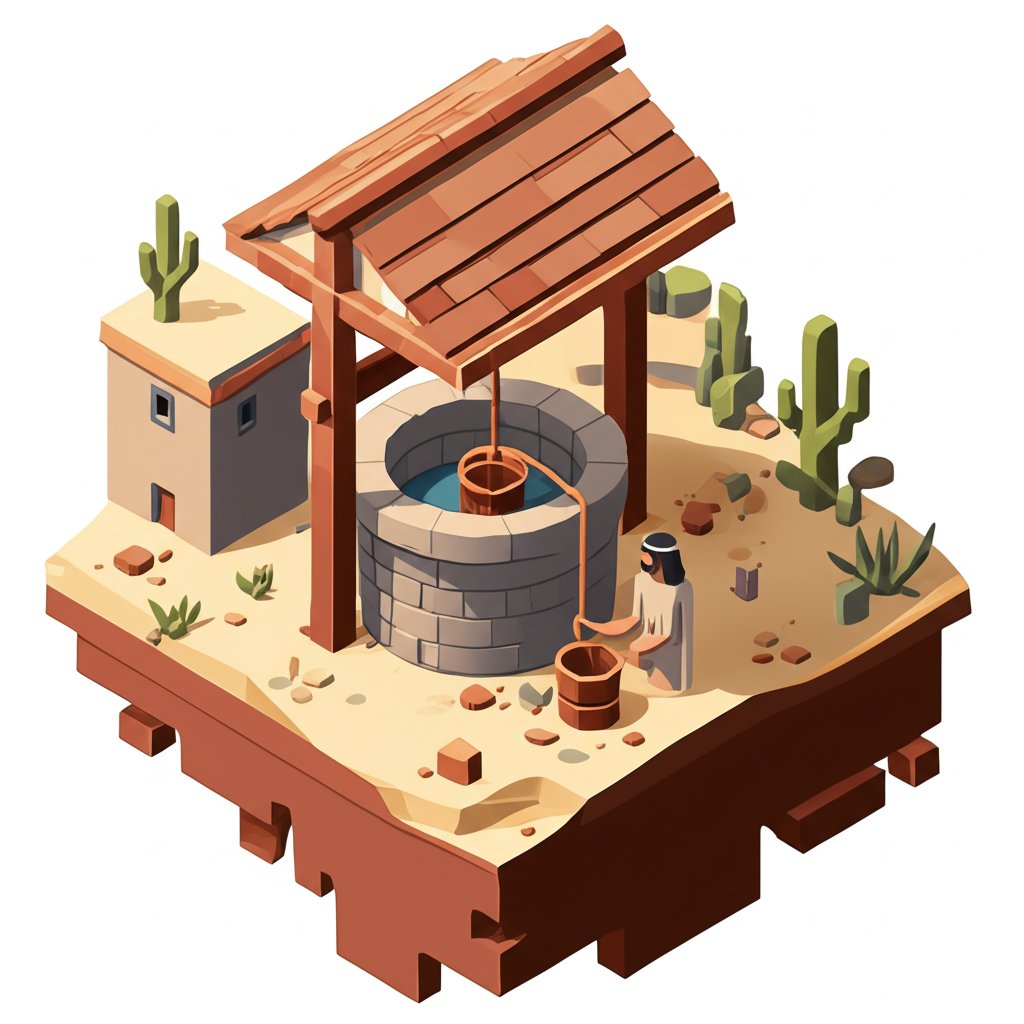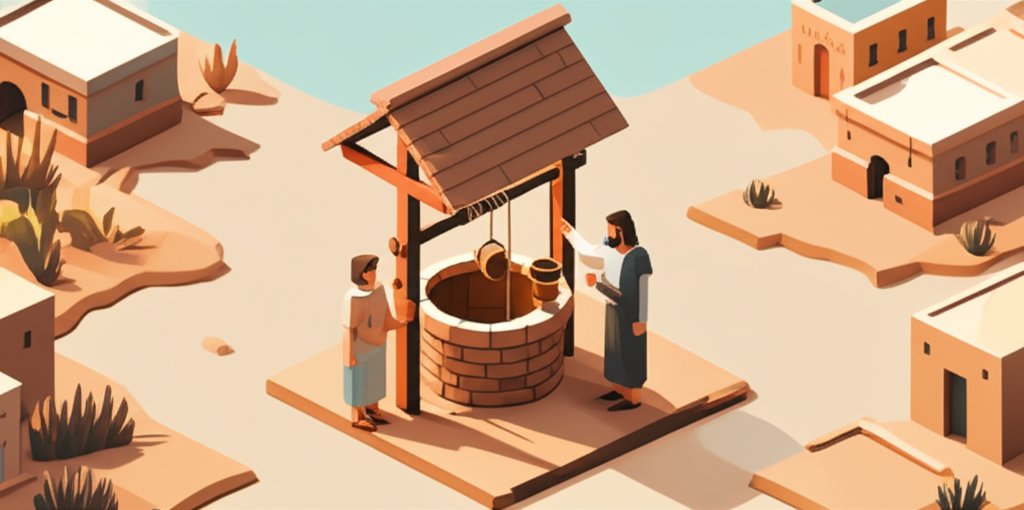Step back in time to an ancient crossroad where history, geography, and profound spiritual revelations converge. For centuries, pilgrims, scholars, and seekers have pondered the exact locations and intertwined destinies of Jacob’s Well and the city of Sychar. How close were these legendary sites? What profound truths unfolded at their nexus? This comprehensive guide will not only pinpoint precisely how far was Jacob’s Well from Sychar but also unveil the rich tapestry of history and sacred secrets that define these remarkable biblical locations. Prepare to discover the definitive answers to questions like where is Sychar today, the true meaning behind the well of Sychar, and the enduring legacy of Jacob’s Well in Sychar.
Pinpointing the Biblical Nexus: Jacob’s Well and Sychar Unveiled

The encounter between Jesus and the Samaritan woman at a well in Samaria, as recorded in John 4, is one of the most culturally revolutionary and spiritually profound moments in the New Testament. To truly grasp its impact, understanding the physical context of the well and the city is paramount.
The Enduring Legacy of Jacob’s Well
Jacob’s Well is not merely a historical landmark; it’s a living aquifer, a testament to ancient ingenuity and enduring faith. Its origins trace back to the biblical patriarch Jacob, who, according to Genesis 33:19, purchased a parcel of land in this region and later bequeathed it to his son Joseph (Genesis 48:22). Tradition, strongly supported by biblical narrative, attributes the digging of this remarkable well to Jacob himself.
Physically, Jacob’s Well is an impressive feat. It’s a hand-dug shaft, approximately 135 feet (over 40 meters) deep, hewn through solid rock to reach the perennial groundwater below. This immense depth highlights the effort and necessity behind its creation, ensuring a reliable water source for generations.
Today, Jacob’s Well is meticulously preserved within the Greek Orthodox Monastery of Bir Ya’qub (Jacob’s Well) in Balata village, near the modern Palestinian city of Nablus (ancient Shechem) in the West Bank. Access to the well is maintained by the monastery, allowing visitors to glimpse its ancient depths and feel its palpable history. Its significance as Jacob’s Well in Sychar (or near Sychar) is primarily tied to the pivotal New Testament event it hosted.
Sychar Unveiled: Locating the Ancient Samaritan City
To understand the encounter at the well, we must locate the city that Jesus entered: Sychar. John 4:5 states, “So he came to a town in Samaria called Sychar, near the plot of ground Jacob had given to his son Joseph.” This verse is crucial for its geographical specificity.
Identifying Sychar: From Scripture to Modern Map
The scholarly consensus identifies ancient Sychar with the modern Palestinian village of ‘Askar. This identification is largely based on geographical proximity to Jacob’s Well and historical accounts. ‘Askar lies just to the north-northeast of the well, perfectly aligning with the biblical description of a nearby city.
Dispelling Confusion: Sychar vs. Shechem
A common point of confusion arises between Sychar and Shechem. While both cities are in the vicinity of Jacob’s Well, they are distinct entities. Ancient Shechem, now identified with the extensive archaeological mound of Tel Balata, is located approximately 1.5 miles (2.4 km) west of Jacob’s Well. Sychar, on the other hand, is much closer.
The Gospel of John specifies Sychar, not Shechem, as the location of Jesus’ encounter. While some ancient texts and interpretations have occasionally conflated the two, modern archaeological and historical research strongly supports ‘Askar as the true site of Sychar, affirming its separate and closer relationship to the well. Thus, when discussing where is Sychar, we are primarily referring to ‘Askar.
How Far Was Jacob’s Well from Sychar? The Crucial Proximity Revealed
One of the most frequently asked questions regarding these biblical sites is their precise geographical relationship. The answer is surprisingly specific and profoundly illuminating.
Jacob’s Well was located approximately half a mile (0.5 miles or about 800 meters) from the ancient city of Sychar.
This short distance is critical for understanding the narrative of John 4. It wasn’t a well within the city walls, but it was easily accessible for the city’s inhabitants, serving as a primary water source, especially for daily needs like those of the Samaritan woman.
Geographical Precision in the Gospel Narrative
The detailed geographical information provided by John’s Gospel—mentioning Sychar, the “parcel of ground that Jacob gave to his son Joseph,” and the well—speaks to the historical accuracy and eyewitness nature of the account. This precision allows us to virtually place ourselves in the scene.
Imagine Jesus, weary from his journey, sitting by the well. He didn’t have to venture far into Sychar, yet the people of Sychar had a vital and readily available connection to this ancient water source. The half-mile distance implies a natural flow of daily life, with people walking back and forth, carrying their water jars. This close proximity made the well of Sychar a natural meeting point, a place where people from the city would regularly gather, making Jesus’ encounter with the woman not an isolated event, but one deeply embedded in the rhythm of local life.
The Daily Journey to the Well of Sychar
For the people of ancient Sychar, a trip to the well was a daily necessity. The half-mile walk to the ancient well of Sychar would have been a routine part of life, often undertaken in the cooler parts of the day. The Samaritan woman’s decision to come at the sixth hour (noon), the hottest part of the day, is often interpreted as an attempt to avoid the usual crowds, underscoring her marginalized status. The fact that the well was outside but close to the city meant it provided a degree of privacy, even if short-lived, for those seeking to avoid social interaction. This specific context elevates the significance of Jesus choosing this particular time and place for His encounter.
The Sacred Secrets of the Well of Sychar: The Samaritan Encounter
Beyond mere geography, the true depth of Jacob’s Well and Sychar lies in the transformative biblical narrative that unfolded there. This is where the “sacred secrets” are truly revealed.
The Narrative of John 4 Unpacked
The story of Jesus and the Samaritan woman at the well of Sychar is a masterpiece of spiritual teaching and social boundary-breaking. Jesus, a Jew, initiates a conversation with a Samaritan woman, a double transgression of the social norms of the time. Jews had no dealings with Samaritans, and men, especially religious teachers, did not engage in public conversation with women, particularly one of questionable reputation.
Their dialogue begins with a simple request for water, but swiftly pivots to a discussion of “living water.” Jesus reveals His divine knowledge of her past, validating His claims and captivating her attention. This encounter transcends the physical act of drawing water, moving into the spiritual realm of eternal life and true worship. The well, an essential physical resource, becomes a powerful metaphor for spiritual sustenance that only Jesus can provide.
Living Water: Symbolic Significance of Jacob’s Well
The imagery of “living water” is central to the encounter at the well of Sychar. In ancient Israel, “living water” referred to fresh, flowing spring water, as opposed to stagnant cistern water. Jesus uses this familiar concept to introduce a profound spiritual truth: He offers spiritual refreshment that satisfies the soul eternally.
The well, a source of life-sustaining physical water in a dry land, perfectly symbolizes the spiritual thirst for meaning, forgiveness, and connection with God that Jesus came to quench. It highlights the contrast between the temporary relief of physical water and the everlasting satisfaction found in Him. This symbolic power of Jacob’s Well in Sychar resonates through centuries, making it a powerful site of reflection on spiritual needs and divine grace. The interaction challenges preconceived notions of who is worthy of God’s grace, as Jesus offers this “living water” to a marginalized Samaritan woman, a revolutionary act that broke down ethnic, gender, and social barriers.
Where Is Sychar Today? Tracing Ancient Sites in the Modern Landscape
For those seeking to connect with these ancient stories, understanding the modern context of Sychar and Jacob’s Well is essential.
‘Askar: The Modern Identity of Ancient Sychar
As established, the modern village of ‘Askar is widely accepted as the site of ancient Sychar. Located just northeast of Nablus, it maintains a close proximity to Jacob’s Well, echoing the biblical description. While ‘Askar itself may not have extensive ancient ruins visible on the surface due to continuous habitation, its historical connection to the Gospel narrative is strong, making it the definitive answer to where is Sychar today. The landscape around ‘Askar, with its agricultural fields and olive groves, still evokes the rural setting that would have surrounded the ancient city.
Visiting Jacob’s Well: A Site of Enduring Pilgrimage
Jacob’s Well remains one of the most significant Christian pilgrimage sites in the Holy Land. Housed within the impressive Greek Orthodox Monastery of Bir Ya’qub (St. Photina), the well is carefully maintained and accessible to visitors. The monastery, built over centuries, protects the well and provides a spiritual atmosphere for those who come to reflect on the biblical encounter.
Pilgrims can descend into the crypt of the church to view the mouth of the well and even draw water from its depths. This tangible connection to such a pivotal moment in Christian history offers a powerful experience, bridging millennia. The monastery’s dedication to St. Photina (the traditional name given to the Samaritan woman) further emphasizes the profound significance of the event that transpired at this very spot, cementing the legacy of Jacob’s Well in Sychar.
Preserving the Past: Archaeological Insights
Archaeological efforts in the region, particularly around Tel Balata (ancient Shechem) and the surrounding areas including ‘Askar, continually contribute to our understanding of the ancient landscape. While direct archaeological evidence for Sychar in ‘Askar can be challenging due to continuous modern habitation, the geographical and textual evidence strongly supports the identification. Ongoing research provides context for the demographics, architecture, and daily life of the Samaritan population during the time of Jesus, enriching our comprehension of the encounter at the well of Sychar.
The Enduring Impact: Why Jacob’s Well and Sychar Still Matter
The story of Jacob’s Well and Sychar is far more than an ancient anecdote; it carries profound implications for faith, history, and human connection that resonate to this day.
A Testament to Biblical Accuracy
The precise geographical details provided in John’s Gospel concerning the relative positions of Jacob’s Well and Sychar, meticulously confirmed by modern research and archaeology, serve as a powerful testament to the historical reliability of the biblical text. This accuracy provides confidence in the narrative, grounding its spiritual truths in verifiable reality. Knowing precisely how far was Jacob’s Well from Sychar allows for a deeper appreciation of the Gospel’s meticulous detail.
A Bridge to Understanding Inter-Religious Dialogue
The sacred sites of Jacob’s Well and Sychar hold significance for multiple religious traditions:
The encounter at the well, specifically between a Jew (Jesus) and a Samaritan woman, highlights themes of overcoming prejudice, engaging with the “other,” and finding common ground. It remains a powerful example of inter-religious dialogue and understanding.
A Call to Spiritual Reflection
Ultimately, the enduring importance of Jacob’s Well and Sychar lies in their spiritual message. The story invites every reader to reflect on their own spiritual thirst, to consider where they seek “living water,” and to examine their own prejudices. It’s a call to embrace a faith that transcends social and cultural boundaries, offering salvation and spiritual refreshment to all who seek it, just as Jesus offered it to the Samaritan woman at the ancient well of Sychar.
Conclusion: Unearthing the Enduring Significance
Our journey through time and scripture has illuminated the precise connections between these biblical landmarks. We’ve definitively established that Jacob’s Well was approximately half a mile from Sychar, a crucial geographical detail that brings the Gospel narrative to vivid life. We’ve uncovered that Sychar is identified with the modern village of ‘Askar, providing a concrete answer to where is Sychar today. Moreover, we’ve explored the profound spiritual significance of the well of Sychar, not just as a water source but as the stage for one of Jesus’ most transformative encounters. The legacy of Jacob’s Well in Sychar continues to inspire and challenge, bridging ancient history with modern faith.
These sites offer more than just historical facts; they provide a tangible link to a pivotal moment where barriers were broken, and eternal truths were revealed. To stand near Jacob’s Well, knowing the exact distance to ancient Sychar, is to connect with a story that continues to offer living water to a thirsty world.
FAQ: Your Questions Answered About Jacob’s Well and Sychar

How far was Jacob’s Well from Sychar?
Jacob’s Well was located approximately half a mile (0.5 miles or about 800 meters) north-northeast of the ancient city of Sychar. This close proximity made it the primary water source for the city’s inhabitants.
Where is Sychar located today?
Ancient Sychar is widely identified with the modern Palestinian village of ‘Askar, which is situated near Nablus in the West Bank. It remains just a short distance from Jacob’s Well.
Is Jacob’s Well truly “in Sychar”?
While Jacob’s Well was not geographically within the city walls of Sychar, it was so close and served the city’s inhabitants as a vital water source that it is commonly referred to in the context of “Jacob’s Well in Sychar.” The biblical text clarifies it was “near” Sychar.
What is the significance of the Well of Sychar?
The Well of Sychar is profoundly significant as the site where Jesus had a revolutionary and transformative encounter with a Samaritan woman, as recorded in John 4. It was here that Jesus broke social and religious barriers and offered her “living water,” symbolizing eternal life and spiritual salvation.
Is Sychar the same as Shechem?
No, Sychar and Shechem are distinct biblical cities. While both were in the region of Samaria and near Jacob’s Well, Shechem (identified with modern Tel Balata) was located about 1.5 miles west of the well, whereas Sychar (modern ‘Askar) was only about 0.5 miles to its north-northeast. The Gospel of John specifically names Sychar as the location of Jesus’ encounter.
Can visitors access Jacob’s Well today?
Yes, Jacob’s Well is accessible to visitors. It is maintained within the grounds of the Greek Orthodox Monastery of Bir Ya’qub (St. Photina) in Balata village, near Nablus in the West Bank. Pilgrims can descend to view the well and partake of its water.
Who was Jacob, and why is the well named after him?
Jacob was a prominent patriarch in the Hebrew Bible. The well is traditionally named after him because, according to Genesis 33:19, he purchased land in the area, and tradition holds that he or his household dug the well to ensure a reliable water supply for his family and livestock.
What is the depth of Jacob’s Well?
Jacob’s Well is approximately 135 feet (over 40 meters) deep, hand-dug through solid rock to reach the water table.










